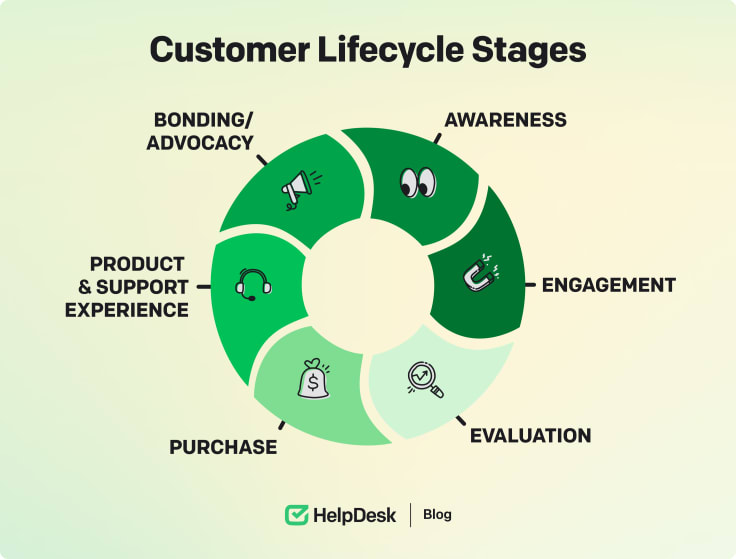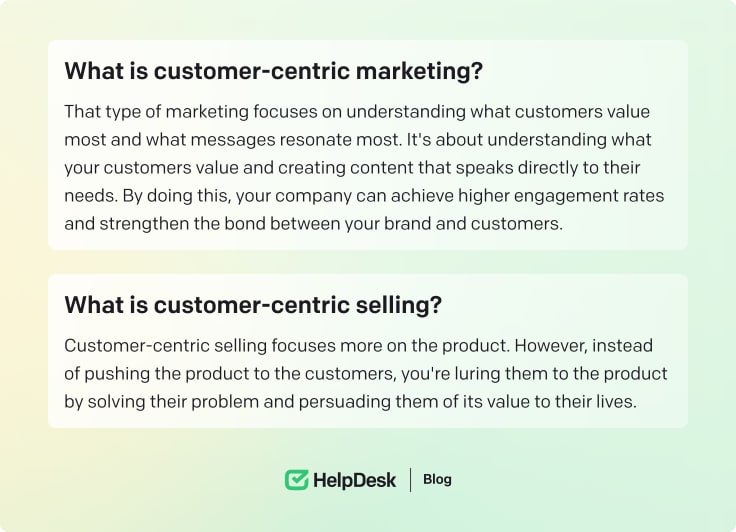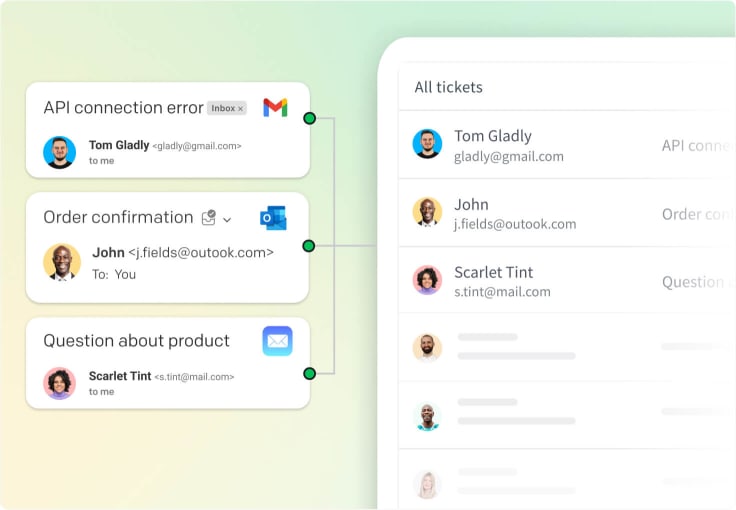Whatever industry you are in, you’ll always need to make your company a cut above all the rest. However, as every company enters with the same ideology, it’s hard to distinguish yourself from the competition when your business hinges on a company’s commitment to its customers.
Customer centricity is a strategy that places the customer on a pedestal, with the customer at the heart of all business decisions. It makes the customers feel more valued and creates loyalty, achieving long-term success.
Through this customer-centric strategy, you’ll have a better customer satisfaction rate, build loyalty, and maximize customer lifetime value while fostering a culture of continuous improvement — all with the customer at its center.
What is a customer centricity?
Most companies practice customer-centricity, a popular business model that prioritizes customers’ needs, wants, and expectations in almost every aspect of the company.
It’s a company mindset that constantly reminds employees of the importance of every customer, influencing everything from marketing to sales, product development, and even customer support. They present everything through the customer’s eyes, including how it’ll affect them and whether it’ll help maintain their loyalty and support.
Customer centricity is fundamentally about solid understanding and empathy for the customer. Companies love this approach because it lets them develop a strong connection with customers, thereby increasing lifetime value.
Benefits of a customer-centric company
Building a customer-centric company that goes deep within the company and its employees or customer service reps can help create a significant impact on a company’s success. Here are a few benefits of having a customer-centric company:
1. Promotes customer loyalty and retention
A customer-centric brand creates a strong bond between customers and the company because customers feel like the company sees, values, and understands them. Because of this, customers are more likely to remain loyal to the brand. Loyal customers will also create more organic referrals, more business, and a lower churn rate, all of which contribute to a more robust bottom line.
2. Helps develop enhanced customer satisfaction
Companies that center their work on customers can offer more positive customer experiences, building trust and satisfaction. After all, customers love getting products that cater to their needs.
3. Improves profitability
Loyal and satisfied consumers are more inclined to buy something from a customer-centric organization that values them and even recommend that company to their friends and family. As a result, you’ll not only gain a boost in sales but also not have to worry about any costs associated with acquiring new customers, leading to higher profitability.
4. Fosters increased employee engagement
When a company values its customers, this also translates positively toward its employees, motivating them to deliver better service. Customer-centric culture fosters a sense of purpose and pride among employees, which can lead to improved performance and overall job satisfaction.
5. Contributes to a better brand reputation
A company constantly prioritizes its customers and earns a strong reputation for credibility and reliability. As a result, it develops a strong brand image that can help draw in even more new clients, creating a competitive edge.
Creating a customer-centric strategy
Understanding the customer-centric approach is as important as knowing how to develop one. Here’s a quick guide on how to create a customer-centric business.
1. Collect and analyze customer data
As customer centricity prioritizes customers’ needs and wants, you first should research and gather data about them. This includes information on their preferences, behaviors, and pain points. Tools like HelpDesk can assist you by tracking and managing customer interactions, providing valuable insights to inform your strategy.

2. Develop customer-focused marketing and selling strategies
Once you’ve researched and clearly understood your customers, you can develop a customer-centric marketing plan that addresses their specific needs and messages that resonate with them. You can create a better strategy using CRM software to build your customer relationship further.
3. Design with empathy
Empathetic design is an essential element of a customer-centric strategy. This method involves developing solutions from the client’s viewpoint. By designing empathetically, businesses can create goods and services that genuinely satisfy their clients.
4. Implement feedback loops
Keeping a customer-centric mindset means routinely gathering and evaluating customer feedback. It can be through online surveys, random customer interviews, QR forms, and email feedback. Genuine customer feedback and reviews can help companies continuously enhance their services and resolve potential issues.
Collect feedback and improve your customer service with HelpDesk. Check out what its reports can do. 📈

5. Prioritize customer relationships
Building solid customer relationships maximizes lifetime value. This entails offering top-notch customer service and actively following up with clients to ensure they make the most of your goods or services, creating a positive customer lifecycle.

Understanding your customer needs
Customer needs are the backbone of every customer-centric business. After all, you can only expect your customers to remain loyal to your company if you address their needs, preferences, and overall customer value.
Your company must continuously conduct market and user research to understand your customers better.
Market research
Market research helps companies understand the bigger picture. Your company will research current market trends, customer expectations, and the competition. By analyzing these factors, your company can use these insights to make informed decisions and help stay ahead of the competition.
User research
User research will help you understand how your goods and services affect customers and how they interact with them. Companies can gather data by asking for feedback, observing customers’ behavior, and analyzing their experiences. It’ll allow companies to guarantee that their products and services align with their clientele’s demands.
Maximizing customer lifetime value
One of the most important objectives for any customer-focused company is to maximize customer lifetime value (CLV). CLV represents the total revenue a customer is expected to generate over their lifetime with the company. As such, companies must focus on creating the best customer experience and building long-lasting relationships.

Here are a few ways you can maximize your CLV.
Deliver solutions that meet customer needs
At every point of the customer journey, it’s essential to prioritize understanding and satisfying the customer’s needs. It entails not just resolving current problems but also predicting needs for the future and providing solutions that will eventually add value over time.
Create positive customer experiences
By creating a positive experience, you are more likely to retain customers and even encourage repeat business. This covers every aspect — from the first time a customer interacts with your business to the assistance you offer after a purchase.
Invest in customer relationships
Developing long-lasting customer relations is crucial to increasing CLV. You can do this by proactively communicating with the customers and having personalized offers, or, in other words, having a customer onboarding so that customers will feel more valued and supported.
Building a customer-centric culture
Building a culture centered on customers’ needs can be challenging as it involves several factors, from top management’s commitment to the employees’ reaction to its full integration — it’s more than asking for the customer’s feedback.
Commitment
Everything depends on the company’s leaders. Treating them as the building blocks of a customer-centric culture is essential. After all, if the leaders don’t act according to their customers’ needs, then there will be no real action. So, leaders must make customer-centric choices and foster a culture of empathy and understanding throughout the organization.
Engagement
Creating an experience focused on the consumer’s needs requires engaged employees and customer service reps. After all, the employees interact with the customers the most. So, when you create a customer-centric culture, employees will be more likely to develop better experiences because of the cause.
Action
Your customers will feel like your company values them by incorporating customer feedback and actively seeking and responding to feedback. By creating a dialogue with the customers, your company guarantees that the company stays in line with their expectations and provides the most excellent experience.
Customer-centric marketing and selling
A customer-centric strategy involves several factors, with customer-centric marketing and selling being the most vital. These factors focus on addressing customers’ needs, wants, and preferences rather than giving out goods and services without thought.

Measuring customer centricity
Measuring customer centricity is crucial for evaluating its effectiveness and identifying areas for improvement. This is precisely where measuring customer support metrics comes in. You can directly determine how well the company addresses customer needs by measuring these metrics:
-
Customer satisfaction: To measure customer satisfaction, you use surveys, reviews, and feedback forms to determine whether your company appropriately addresses customers’ needs.
-
Customer retention: Retention rates are a critical measure of customer loyalty. A high retention rate means that customers are satisfied with the company and its services and are likely to use its products and services.
-
Customer lifetime value: CLV measures the total revenue a customer is expected to generate over their lifetime. It helps businesses understand their customers’ long-term value and the impact of their customer-centric strategies.
-
Net promoter score (NPS): The NPS metric determines customer loyalty by measuring how likely customers are to share the company with their family and friends. A high NPS indicates strong loyalty and satisfaction.
Take care of your customer satisfaction with HelpDesk. Be there for them on any channel they want you to be. 🔥
Overcoming common obstacles
Whether you’re a start-up learning to survive or a struggling company that needs to try something new, creating a customer-centric strategy can be challenging.
One of the most common obstacles is the change everyone, including the management, must undergo. It’s not easy to change one mindset to another. However, aside from that, there are also data silos and a lack of customer feedback. Despite this, companies must overcome these obstacles to meet customer needs.
Here are some ways to overcome common obstacles to customer-centricity.
-
Break organizational silos and encourage data sharing among teams: Organizational silos are often a common obstacle to achieving customer-centricity. While data silos have historically been a challenge for organizations and their marketing teams, businesses today confront a new array of difficulties. The boundaries between marketing, sales, and customer support teams are now more ambiguous. Customer insights and data are no longer exclusively the concern of marketing teams.
-
Empower employees to focus on high-value experiences: Customers want to feel special. To do this, employees should pay 100% attention to them and always provide personalized support. With one-on-one customer service, customers can quickly feel heard and valued.
-
Encourage customer feedback whenever possible: Feedback is a powerful tool that enables companies to identify their strengths and work on improving their weaknesses. Thus, employees should encourage customers to provide genuine feedback about the company’s products and services to ensure that they have the correct data to use.
Case studies and examples
Many companies worldwide have practiced customer centricity for years to deliver solutions that meet their customers’ needs and exceed their expectations. Companies like Apple, Tesla, and Zoom are examples of customer-centric organizations.
If you’re looking to employ a customer-centric strategy for your business, you can learn from these companies, understand their value propositions, and apply them to your business strategies.
1. Apple
Value Proposition: “The ultimate personal device — powerful, easy to use, and designed for your life.”
Apple has crafted a brand synonymous with innovation, elegance, and user-friendliness, which is why it’s a popular customer-centric organization worldwide. The iPhone is not just a smartphone but an extension of one’s lifestyle, integrating seamlessly into everyday tasks with intuitive features and cutting-edge technology. The ecosystem Apple creates with its products ensures users experience a smooth transition between devices, reinforcing loyalty and making the iPhone indispensable to those who appreciate premium quality, reliability, and the latest mobile technology.
2. Tesla
Value Proposition: “Sustainable energy. Zero emissions. High performance.”
Tesla positions itself at the intersection of environmental responsibility and technological advancement. Its electric vehicles are more than just cars; they’re a statement about the planet’s future. Tesla targets forward-thinking consumers who prioritize sustainability but refuse to compromise on performance. With a focus on innovation, from autopilot features to long-range batteries, Tesla appeals to tech enthusiasts and eco-conscious drivers alike, making it a leader in the electric vehicle market.
3. Zoom
Value Proposition: “Meetings without limits — anywhere, anytime.”
Zoom has revolutionized how businesses communicate, offering a platform that is easy to use, reliable, and adaptable to various needs. Zoom enables seamless connectivity across geographies for casual check-ins or critical business discussions, making it indispensable in today’s remote and hybrid work environments. The company’s emphasis on user experience, with features like screen sharing, breakout rooms, and high-quality video and audio, ensures that meetings are productive and professional, appealing to a broad range of users, from individual freelancers to large corporations.
The role of technology in customer centricity
Technology plays a critical role in enabling and enhancing customer centricity. As customer centricity relies on data gathered from the customers, you can adequately integrate or adopt a customer-centric culture efficiently without using technology, especially with what it has to offer.
In addition, tools like CRM systems, customer support software, and marketing automation platforms help companies manage customer relationships better and easier, ensuring that every interaction is consistent, timely, and relevant.
By leveraging technology, mainly by using HelpDesk and its various tools to help you and your company analyze data and research, businesses can create seamless, cohesive experiences that drive customer satisfaction and loyalty.

Staying ahead of the competition
Competition is everywhere, and one way to survive is to step ahead. In a competitive marketplace, staying ahead requires a continuous commitment to innovation and improvement. As such, it’s essential always to prioritize research and data analysis to identify customer needs and current trends.
Additionally, it’s essential to develop goods and services that directly cater to the evolving needs of customers, which may require a deep understanding of the customer journey. By consistently prioritizing the customer and utilizing helpful tools like HelpDesk and their software, companies can build a loyal customer base while staying ahead of the competition.
Summary
Customer centricity is a powerful mindset at the core of many successful businesses. Focusing on customer needs and placing them at the center of your strategy can significantly boost sales and foster loyalty, leading to long-term success. While the initial shift toward a customer-centric approach may present challenges, the benefits — such as increased customer satisfaction and a more substantial brand reputation — far outweigh any obstacles.
While integrating customer-centricity into the company might initially be challenging, its benefits ultimately outweigh any obstacle you might encounter. Your business will surely succeed by understanding customer needs, maximizing lifetime value, and fostering a customer-centric culture.






